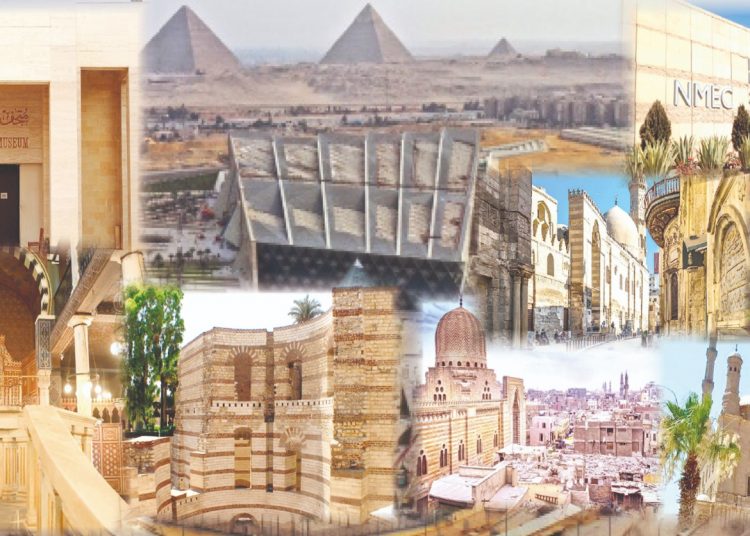The Egyptian capital is a unique destination for short city breaks, offering a variety of attractions and experiences.
The Tourism and Antiquities Ministry and other relevant authorities are working tirelessly to promote this independent tourism product, which showcases the rich cultural heritage and modern amenities of the city.
The product Cairo Short City Break focuses on tourists who want to explore the culture and history of one of the world’s oldest and most lively cities, while aiming to increase the average length of stay in Cairo from two nights to five nights.
This comes as a result of the State’s efforts to upgrade infrastructure, which has seen progress in the network of roads, transportation, airports, new railways, and the activation of new airports.
These factors help the tourism sector by making it easier to move tourists and provide them with various tourism experiences. They also reduce the travel time between different tourist cities and link the Red Sea coast with Luxor, Aswan and Cairo.
The ministry’s Supreme Council of Antiquities (SCA) supported the Cairo Short City Break product, which added more attractions to the Cairo sightseeing programme last year.
The Darb Al-Ahmar tourist route is one of these sightseeing destinations. The start of the two-kilometre route is the visitor centre in Al-Azhar Park where you can watch a video in many languages about the path, the history of el-Darb el-Ahmar and structures of archaeological interest.
Visitors riding in eco-friendly electric cars from Al-Azhar Park will be taken past the mud brick eastern Ayyubid Wall, built by the founder of Cairo, Gawhar Al Siqili. Further along the route is the Tarabay al-Sharifi Complex, completed in 1516 with its helmet-shaped dome dating back to the Circassian Mamluk era among other monuments.
The route is a great opportunity to get to know another side of Cairo, away from the hustle and bustle of the modern city.
The sightseeing programme also includes the Old Cairo area and its important archaeological landmarks such as the Hanging Church, the Church of St. George, and the Church of Abu Serga, which includes the cave where the Holy Family stayed, as well as the Coptic Museum, in addition to the Babylon Fortress and the Ben Ezra Synagogue, which were opened last year.
Another stunning destination is the Grand Egyptian Museum (GEM), a world-class cultural attraction near the Giza pyramids. It showcases over 100,000 items from Egypt’s ancient history, including the full collection of King Tut’s belongings. Using cutting-edge technology and creative design, the museum, which is set to open this year, offers visitors a rich and engaging journey through the past.
The Saladin Citadel is also one of the most iconic landmarks of the Egyptian capital. It was built by the famous Muslim leader Salah al-Din in the 12th century to protect the city from the Crusaders. The citadel is located on a hill overlooking the old city, and contains several mosques, museums, and palaces that reflect different eras.
The Citadel tour has been expanded with new attractions that showcase the history and culture of Egypt. In addition to its known landmarks, visitors can now explore the Süleyman Pasha Mosque, the first mosque in Egypt built in the Ottoman style in 1528, and climb two of the Citadel’s towers for the first time in addition to establishing restaurants and cafeterias. These additions will make the tour last three or four hours, instead of the previous 40 to 50 minutes.
The Imhotep Museum, located at the foot of the Saqqara necropolis, is another new attraction. The museum celebrates the ancient Egyptian architect Imhotep, the enforcer of the hierarchical group of King Djoser, as the first to erect a pyramidal building using stone.
Visitors can learn about his life and his contributions to the development of civilisation. The museum also displays artefacts and relics from the Saqqara complex, such as statues, stelae, coffins and mummies.
Moezz Street is a historical street in Cairo that reflects the Islamic civilization’s legacy. It was founded in the 10th century by Al-Moezz, the Fatimid caliph who established Cairo, and it runs between Bab Zuweila and Bab al-Futuh, two old city gates.
The street features many Islamic monuments and buildings from different periods and styles, such as mosques, mausoleums, schools, and houses.
Two historic mosques were opened last year, the 11th-century Al-Hakim Mosque and the 12th-century Al-Aqmar Mosque.
In addition, the street has recently undergone a signage project in collaboration with the UNESCO Office in Cairo to enhance the interpretation and presentation of the archaeological sites that are part of the UNESCO World Heritage List.
The first phase of the project has installed 40 informational signs for 14 archaeological sites and a map of the street and its monuments. Each sign has a QR Code that allows visitors to access historical and architectural information and archival photos of each site. The project has also added umbrellas and wooden benches along the street for visitors’ convenience.
The second phase of the project will start soon and will include the remaining monuments on the street.
The SCA mission has unearthed new artefacts that enrich the collections of the National Museum of Egyptian Civilisation in Fustat and the Egyptian Museum in Tahrir. The new discoveries reveal more aspects of the life and beliefs of the Egyptians in different periods and regions.






Discussion about this post